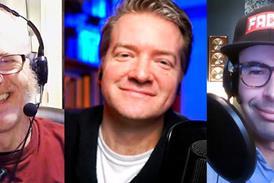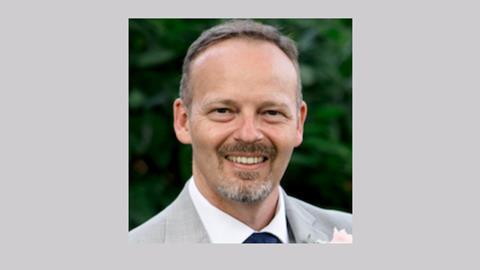Jim Thring was a Christian for 15 years before losing his faith and becoming a humanist atheist. He rediscovered his Christian faith years later through apologetics. Jana Harmon shares some of Jim’s story here
Jim Thring was a committed Christian for 15 years. He then left his faith in his mid-30s, passionately identifying as a humanist atheist for the next nine years. During that time, he genuinely could not see how he could possibly go back to believing in God again. Yet, against all odds, he discovered a more robust form of Christianity than the one he left behind and reconverted. What changed his mind?
Coming to faith
Raised in London with a typical British upbringing, Jim saw religion through pageantry and tradition as tied to the Church of England. Christianity was ‘nice’ as a religious ritual, but it wasn’t something in which he was invested or gave much thought. After all, as a young person, he was eager to explore all that life had to offer.
During university, social opportunities came in abundance at the cost of his own studies. He decided to change direction and find friends who were taking their coursework more seriously. Jim then found himself in the company of Christians on his hallway and was invited to go to church. After attending a few services, he became curious about Christianity. His questions led to faith:
“I said to one of them: ‘I’m confused. What is a Christian?’ And then he told me a Christian is someone who believes in Jesus and has decided to follow him and that this was a personal decision you made, not something you are granted by an official. It suddenly dawned on me that faith and religion can be quite different things. It’s one thing to have faith in and to follow and be committed to the person of Jesus Christ. It’s another thing to just adopt a religious framework and all of the trappings that come with that.
Read more:
Death has lost its sting
Fighting against God
Finding God through science
The despair of meaninglessness
I was amazed by that. That was a real revelation to me, because having come from no Christian background at all, I was relieved and amazed and very grateful that actually I could call myself a Christian based not on meeting certain requirements of an institution. So, that was how I first became a Christian. At the age of 19 at university in Scotland. And I remained a Christian for 15 years.”
Fading Christianity
Jim took his faith seriously, reading his Bible, praying and talking to others about Jesus while at university. After graduation, he spent a year on mission in Kenya teaching at a school and preaching in a church. Returning to London, he attended church where he met his wife and they started a family. There was no doubt in his mind that he was a committed Christian, that he had chosen to follow Christ.
But slowly over time things changed. Reflecting, he recalled that he became more concerned with “what I knew and whether I was right about things” than with his relationship with God. The daily grind of life, marriage and work also took a toll on his faith. Meeting “good people who were getting on with life”, who weren’t Christians, also showed him a way to live without God. His faith felt more ordinary and mundane, fading away, becoming less distinct from any other religion or worldview.
Jim’s daily life began to look more different than his Sunday church appearances. This compartmentalised living caused him to question disagreements and denominations among different churches. For him, “Christianity and church were becoming a smaller and smaller island of people who agree with you”.
Questions
Struggling emotionally and intellectually with faith at this point, Jim’s faith simply eroded away.
“A combination of all of these different things brought me to a point where my faith became like a philosophy, really. More about what I knew and not about personal relationship. And once God doesn’t mean that much to you in your daily life, the next logical step is, ‘Well, then why believe? Why go on believing?’ And so I started to investigate some questions. I was still a believer, but I was kind of looking at things. I was probably more challenged around questions of science, particularly around origins and evolution. I was asking myself questions about salvation and what happens to people who haven’t heard the gospel. These kind of things that are challenges and we try to grapple with. But I did it very much in isolation. I didn’t really talk to people about it. It was more of an introverted journey that I went on. And I think things just started to erode away.
Jim thought he could live with his fading faith for the sake of his marriage and their friendships, but he couldn’t. A pivotal moment of decision came six months later when he was asked to give his testimony of how he came to faith in Jesus. He knew he could not, responding: “Look, I’m really sorry, but I won’t be coming to church anymore. I just don’t believe anymore.” After that, he stopped attending church. Looking back, he recognised his resistance in both head and heart, reflecting:
“Even in my atheism and my scepticism, while I was convinced that it was purely on intellectual grounds, there was definitely a heart decision to it as well, and I don’t think I was fully honest with myself at the time, but I was already determined not to believe. And the kind of intellectual questions I had and the arguments that I felt I’d formulated and heard, particularly online from the New Atheists like Richard Dawkins and Christopher Hitchens, they were really just a means to substantiate the decision that I’d made to leave church and to give me good grounds for it and to feel that I’d done the right thing and it was rational and reasonable.”
Honest atheism
Jim lived as an atheist for nine years. Having left God and the Church, he wanted to “land somewhere,” recalling: “I wasn’t satisfied with saying what I didn’t believe. I certainly felt, ‘Well, what do I think, then? I don’t want to be a non-person. I don’t want to be somebody who just doesn’t believe. I do want there to be some kind of foundation for my life. What is that?’”
Searching on the Internet, he found the term ‘humanism’ and decided to become a humanist, someone who values morality, reason and purpose as coming from a shared human collective view. This seemed a more attractive and positive form of atheism.
Jim also understood that if there is no God, then all that exists is the natural world. He embraced Dawkins’ view that “we are just dancing to the tune of our DNA and to the sound of the Universe, and this Universe is not personal”. He understood that “there is no hope and there is no purpose” and that is how he felt. For Jim, this was “honest atheism”. The most important thing for him was to be true to himself. He described this “first phase of scepticism”:
“I’d wrap myself up in these warmly affirming, ‘You’re right to be an atheist. Here’s some really clever words and some clever arguments to keep you in that position, and whenever your wife gets home from church with the kids, you just remember that you just got the latest newsletter from the British Humanist Association through the post and read that’. I would just do all these things. I wasn’t very adversarial or combative because I knew my wife was going to church still. I didn’t actually meet with humanists personally and join the group. I did all of this very much at a distance, just within myself. Probably because I felt that actually that might be too much. It might just cause there to be too much conflict.”
Get access to exclusive bonus content & updates: register & sign up to the Premier Unbelievable? newsletter!
Fading atheism
After a few years, Jim became less convinced by atheistic arguments, that they seemed to be shaped by what they were against – religion and religious people – than what they were for. He tired of their constant ridicule and decided not to renew his membership in the British Humanist Association, wanting to distance himself from the mockery. He carried on with life, joined a band, did creative things.
As an ‘ex-Christian’, he would try to explain to other non-Christians how difficult it had been to change his entire way of thinking from belief to unbelief. On one occasion, the other person responded: “Well, you don’t know. One day you might come back to faith. You might change your mind.” Jim responded: “I can’t honestly see how that would be possible.”
As far as he was concerned, he had “pulled back the curtain and revealed what the real truth was”. And it wasn’t found in Christianity, or so he thought.
Questioning life
A couple of years later, Jim began to question the meaning and purpose of his life. As an adult, he had achieved everything his younger self would have wanted, but somehow it still felt empty. He had a great job, family and home. He was enjoying his life but nagging questions haunted him:
“I just went: ‘Yeah but so what? What do I do next? What is the rest of my life going to be like? And where is meaning and purpose in life?’ And that question came up again, the big ‘So what?’ question. What is the purpose of life? What meaning is there? Is it just manufactured? Is it just a way of coping to get through your existence? And I kind of had this little alarm bell, going: ‘Uh oh. Hang on in a minute. Let’s not go there. That’s going to lead me to God again’, so I kind of brushed that under the carpet.”
One day, Jim was thinking about his career, wondering if he should do something different. As a Christian he would have prayed about it. As an atheist, that option was no longer open him. For the first time in a long time, he began to ponder why he chose to walk away from his faith. Reflecting on his life decisions, he decided to look once more at the obstacles that kept him from belief.
Making a decision
Jim decided one of his biggest obstacles was the apparent irreconcilability of science and belief in God. Searching for a good book on the subject by a reputable author, he found Gunning for God by John Lennox, an Oxford professor. Reading Lennox’s counter-arguments to the New Atheists through this and other books challenged his own thinking.
“I was confronted with the realisation that I’d probably put obstacles in the way of faith that weren’t really legitimate obstacles that were kind of false obstacles and barriers to continuing believing…I started to unpick this view that reason and rationality and logic are tools that are exclusively for use by atheists and nontheists and sceptics and that faith is something that is purely a blind faith.”
Once he realised there were substantive answers given by intelligent Christians for their worldview, Jim began to watch sermons online and was re-introduced to the ‘gospel’ or good news of Jesus. One day, he went for a walk and was contemplating everything when he thought:
“I could investigate everything and keep investigating and then look at the counter claim or counter argument and then look at the counter-counter argument and keep going. How much knowledge do I have to amass before I can be satisfied on this question of whether God exists or not and whether he wants to relate to me or not? And I realized that, if I’m not careful, my project that I’d embarked on would just be this never-ending constant series of questions. It’s good to question. It’s absolutely right that we ask questions. But at some point we have to get to a stage where we stop and make a decision.”
Coming to that resolution, Jim said his first prayer in nine years: “OK, God. If you’re there and you’re real, I’m prepared to think about you again.” A couple weeks later, he decided that he should step back, take time, reflect and look at the big picture of Christianity rather than just the individual parts. He wanted a view of the world that made the most sense of what he knew and experienced. He found:
“The thing that made most sense of what I observed in the world around me and what my experience of life was, the thing that made the most sense about that, was that there was a God, that he does exist, that we are created beings, that we are immaterial minds and not just physical brains, that the Universe hasn’t existed for eternity and didn’t just pop into existence by magic but had a beginning, and that there is a meaning to life that has been given to us externally by a God who has given life meaning in the first place and given us meaning.”
In that process of reflection, he said another prayer: “God, I’m yours again. I’m back.” Jim found once more the faith he left behind. This time it was much more solid than before.
If you’d like to listen to Jim Thring tell his full story, tune into the Side B Stories Episode 28 or you can find it on the Side B Stories website at www.sidebstories.com.
Jana Harmon hosts the Side B Stories podcast where former atheists and sceptics talk about their turn from disbelief to belief in God and Christianity. She is a teaching fellow for the CS Lewis Institute of Atlanta and former adjunct professor in cultural apologetics at Biola University where she received an MA in Christian apologetics. Jana also holds a PhD in religion and theology from the University of Birmingham in England. Her research focused on religious conversion of atheists to Christianity and related book is entitled, Atheists Finding God: Unlikely Stories of Conversions to Christianity in the Contemporary West.























